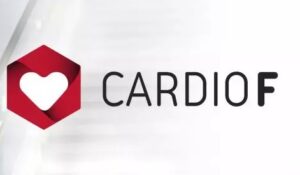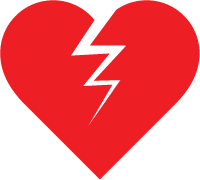The Automated External Defibrillator (AED)

An automated external defibrillator, commonly referred to as an “AED,” is a device used to assist someone who has collapsed, is unresponsive, and may require emergency intervention to save their life.
This small, portable device is battery-powered and incredibly user-friendly. Anyone can operate it, regardless of whether they have received prior training in cardiopulmonary resuscitation (CPR).
Location Signs
In public places, pictograms featuring a lightning bolt or the words “defibrillator” or “AED” (automated external defibrillator) are becoming increasingly common.
These signs indicate where an AED is available. It is crucial to be able to quickly identify these locations in case of an emergency.

Double Function
The AED serves a dual purpose: delivering one or more electric shocks in emergencies and guiding rescuers through resuscitation procedures.
Once the electrodes are placed on the bare chest of the collapsed individual, the device monitors and analyzes the heart’s electrical activity. If a potentially life-threatening arrhythmia is detected, the AED alerts the rescuer that an electric shock will be delivered and instructs them not to touch the patient. After delivering the shock, the device continues to guide resuscitation efforts.
In some cases, the AED determines that an electric shock is not necessary. In such situations, it becomes a valuable tool for assisting and supporting the rescuer throughout the resuscitation process.
Why It Matters
Outside of hospitals, 80% of cardiac arrests occur at home or in public places, highlighting the critical importance of a swift response. Quickly initiated cardiopulmonary resuscitation (CPR), combined with early defibrillation, can increase survival rates after cardiac arrest by up to 85%.
Every Minute Counts
In cases of cardiac arrest with ventricular fibrillation, every second is critical. Survival chances decrease by 7% to 10% for each minute without intervention.
This means that after 10 minutes without defibrillation, survival becomes minimal.
This underscores the importance of awareness and accessibility to devices like AEDs in public spaces, local communities, and even homes. Initiatives such as icardio.ca, which aim to make cardiovascular health knowledge accessible and practical, emphasize the need to integrate these preventive tools into daily life. True prevention, after all, depends on swift action and a better understanding of life-saving measures.

Someone is Down!
When someone collapses, there can be many possible causes.
The important thing is to remember that anyone can step in and help.

- Check for Responsiveness
Approach the person and try to stimulate them by calling out:
“Ma’am, Sir, can you hear me? Squeeze my hand if you can hear me!”
If the person remains unresponsive and unconscious, it’s time to act. Call for help immediately and ask someone nearby to dial 911.
- Start CPR

If you are trained in cardiopulmonary resuscitation (CPR)
Begin chest compressions right away. If you are not trained, don’t panic. Ask those around you if anyone knows CPR. Quick collaboration can make all the difference for the victim.
Remember, every minute counts. Taking action, even imperfectly, is always better than doing nothing.
No One Knows CPR
Don’t panic.
Even without prior training in cardiopulmonary resuscitation (CPR), all is not lost.
Follow these steps:
- Call 911 Immediately
The operator will guide you step by step on how to proceed. They are trained to assist in these situations and can explain how to begin simple and effective CPR. - Look for an AED (Automated External Defibrillator)
If an AED is available nearby, ask someone to retrieve it while you follow the operator’s instructions. AEDs are designed for use by non-professionals and provide clear guidance to help you respond quickly and effectively.
Even without medical knowledge, your actions can make a critical difference. Don’t wait—take action!
An AED is Available
When you call for help, someone brings you an AED.
Everything is under control! Stay calm!
When an Automated External Defibrillator (AED) is made available to you, you are already better equipped to save a life.
Here are the key steps to follow:
Listen to the Voice Prompts
Open the AED case or pouch. The device will start giving voice instructions as soon as the lid is opened or the device is activated.


- Apply the Electrodes
- The device will say: “Apply pads to the patient’s bare chest.”
- Look at the diagrams on the pads to see where to position them.
- Connect the Electrodes
- Attach the pads to the AED unit as instructed: “Connect the electrode connector to the flashing light.”
- Analyze the Heart Rhythm
- The device will say: “Analyzing patient’s heart rhythm. Do not touch the patient.”
- Stand clear to avoid interference during this analysis.
- If a Shock is Required
- The AED will guide you:
- “Shock advised. Charging. Stay clear of the patient.”
- Ensure no one is touching the victim.
- “Deliver shock now. Press the orange button now.”
- The AED will guide you:
- After the Shock
- The device will say:
- “Shock delivered, pausing.”
- “If necessary, begin CPR.”
- If the victim does not respond, the AED will guide you to continue CPR and may administer another shock if needed.
- The device will say:

Important Reminder
The AED is designed to be used by anyone, even without prior training. Following its step-by-step instructions can significantly increase the victim’s chances of survival. You are a critical link in the chain of survival!
Sometimes, an Electric Shock Is Not Necessary
In certain situations, the device determines that an electric shock is not required. This may occur if the AED does not detect a life-threatening arrhythmia in the victim.
What to Do in This Case?
- Follow the Device’s Instructions
- The AED will announce: “No shock advised.”
- It will then guide you to initiate or continue cardiopulmonary resuscitation (CPR), if needed.
- Continue Resuscitation Efforts
- Perform chest compressions and rescue breaths if you are trained, or follow the instructions from the 911 operator if you are not.
- Persist Until Help Arrives
- Keep up the resuscitation efforts while following the AED’s vocal prompts. The device will continue to monitor and analyze the heart rhythm, adjusting its recommendations in real time.
Every second counts. Even without an electric shock, your actions can stabilize the victim and provide them with a better chance of survival until first responders take over.
Data Recording
The Automated External Defibrillator (AED) is equipped with a memory chip that records all steps of the intervention. This includes the device’s analyses, any shocks delivered (if applicable), and the actions taken by the rescuers.
Why Is This Useful?
- Evaluation of Actions Taken
- The recorded data allows for verification of whether the resuscitation efforts were carried out according to the device’s instructions.
- This can be especially helpful in identifying areas for improvement in emergency response procedures.
- Post-Intervention Analysis
- The information captured provides a detailed overview of the events, helping healthcare professionals better understand the situation.
- These records can also be used for educational purposes or to train rescuers for future interventions.
- Improvement of Efficiency
- By reviewing these recordings, rescuers can assess the quality of their response and refine their skills in CPR and AED usage.
The AED is not just a life-saving tool but also a valuable resource for learning and enhancing resuscitation practices.

In Conclusion
You have the power to change the outcome for someone who collapses and is unresponsive.
The rapid use of an Automated External Defibrillator (AED) significantly increases the chances of survival, as every minute—every second—counts.
Remember: anyone can use an AED. Simply follow the clear voice instructions provided by the device.
Together, let’s take action to save lives.
























